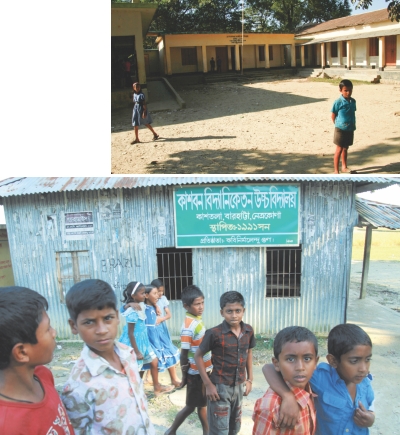| Home - Back Issues - The Team - Contact Us |
 |
| Volume 11 |Issue 14| April 06, 2012 | |
|
|
Education Kashban – A vision for Creative Education Michael Chew and Kanika Chakraborty As the peel of bells call across the rice fields, small figures gather on a stage under the golden sky. The sound of drums joins that of the bells, and hundreds of faces turn towards the stage. A lone figure steps from the shadows and begins to sing…
The event is a cultural show, showcasing the songs and stories of the past to a community. Such shows are common across Bangladesh, but what makes this particular show different is that the performers are all local children, and the stage is situated in a school in a remote village in the outer district of Netrokona. The event is part of a visionary education programme called 'Kashban', led by the famous poet Nirmolendu Goon. The primary school was established by his grandfather as the first in the Barhatta Upazilla over a hundred years ago, and is now run by the government, while he himself set up the secondary school in 1991 to address the lack of opportunities in the area. Although Bangladesh has made significant strides in population control, health, gender equality and so on, our education system still lags behind. Schooling has remained traditional, with very little changes since independence. In particular, rural areas face the most limitations in education, despite the efforts of countless government and NGO-led initiatives and programmes. Most educational programmes still rely on conventional techniques and leave very little room for creativity in learning. This is where the visionary programme of Nirmolendu Goon stands out from so many others. In his vision, creativity and education are fundamentally linked; through supporting and nourishing a child's natural creativity, we can foster their openness and desire. While many schools offer some creative opportunities – such as art and music programmes – these tend to be very few; they are also crowded, with children often not receiving any individual attention. Kashban is different in having a dedicated infrastructure – separate art and music schools, and a performance stage – so that students have space and sustainable opportunities for creative learning and practice. Nirmolendu Goon has a broader vision for the school in addition to making a positive impact on student's learning. He sees it as a catalyst for spreading learning across the whole community. The students of his school regularly perform for their own community. These events – with their vibrant colours, music, and play – draw all kinds of people. Traditional songs and stories are told, and the young and old alike enjoy the experience. During the events, the audience has the opportunity to explore the educational buildings – the library, school rooms etc. It gives rural people, many of whom have never seen such a place or handled books and educational materials, the opportunity to familarise themselves with an environment of learning. Event by event, and conversation by conversation, more and more people are able to see and appreciate the school and what it stands for. In this way creative programmes raise awareness about the importance of broader education.
However, change is never easy, and Kashban has faced many problems in its hundred year history. Perhaps one of the most major barriers is the poor economic status of the students and their families; their meagre incomes hardly allow for them to spend money on their children's education. As such, the fees are less than that of government schools, and education is free for primary students. Thus, the school cannot rely on fees to fund much of its programmes. Nirmolendu Goon himself raises a large proportion of the funds through his exemplary exhibitions of paintings in Bangladesh and abroad. In addition, student attendance is an ongoing issue – as is common in a majority of rural areas, children face barriers of distance and work commitments (in and out of the home) that prevent them from attending school. Despite these limitations, the school is growing and developing, and attracting more and more attention. A growing number of interested outsiders – government officers, poets, performers, educators – visit the school to listen to and learn from the initiative. Their presence also inspires the community to realise the importance and uniqueness of their own school. In December 2011 Kashban launched a new specialised art school, which is even attracting students from other schools. The local government has been impressed by the overall initiative, and has given money to redevelop the school building. There is a great potential for replicating this initiative across Bangladesh. However, so far this has not been realised. Nirmolendu Goon's vision for the school – begun by his grandfather as a nascent seed almost 100 year earlier – has flowered into a strong and vibrant sapling. Hopefully this young tree will keep growing, inspiring its students and community for years to come.
|
||||
Copyright
(R) thedailystar.net 2012 |

